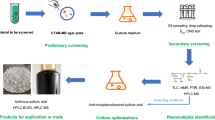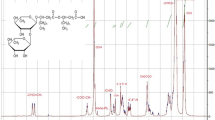Abstract
Rhamnolipids are surface-active agents with a broad application potential that are produced in complex mixtures by bacteria of the genus Pseudomonas. Analysis from fermentation broth is often characterized by laborious sample preparation and requires hyphenated analytical techniques like liquid chromatography coupled to mass spectrometry (LC-MS) to obtain detailed information about sample composition. In this study, an analytical procedure based on chromatographic method development and characterization of rhamnolipid sample material by LC-MS as well as a comparison of two sample preparation methods, i.e., liquid-liquid extraction and solid-phase extraction, is presented. Efficient separation was achieved under reversed-phase conditions using a mixed propylphenyl and octadecylsilyl-modified silica gel stationary phase. LC-MS/MS analysis of a supernatant from Pseudomonas putida strain KT2440 pVLT33_rhlABC grown on glucose as sole carbon source and purified by solid-phase extraction revealed a total of 20 congeners of di-rhamnolipids, mono-rhamnolipids, and their biosynthetic precursors 3-(3-hydroxyalkanoyloxy)alkanoic acids (HAAs) with different carbon chain lengths from C8 to C14, including three rhamnolipids with uncommon C9 and C11 fatty acid residues. LC-MS and the orcinol assay were used to evaluate the developed solid-phase extraction method in comparison with the established liquid-liquid extraction. Solid-phase extraction exhibited higher yields and reproducibility as well as lower experimental effort.

ᅟ





Similar content being viewed by others
References
Soberón-Chávez G, Maier RM. Biosurfactants: a general overview. In: Soberón-Chávez G, editor. Biosurfactants. From genes to applications. Heidelberg: Springer-Verlag; 2011. p. 1–12.
Edwards KR, Lepo JE, Lewis MA. Toxicity comparison of biosurfactants and synthetic surfactants used in oil spill remediation to two estuarine species. Mar Pollut Bull. 2003;46(10):1309–16.
Poremba K, Gunkel W. Marine biosurfactant, III. Toxicity testing with marine microorganisms and comparison with synthetic surfactants. Z Naturforsch C. 1991;46(3–4):210–6.
Sekhon Randhawa KK, Rahman PK. Rhamnolipid biosurfactants—past, present, and future scenario of global market. Front Microbiol. 2014;5:454.
Lang S, Wullbrandt D. Rhamnose lipids—biosynthesis, microbial production and application potential. Appl Microbiol Biotechnol. 1999;51(1):22–32.
Müller MM, Kügler JH, Henkel M, Gerlitzki M, Hörmann B, Pöhnlein M, et al. Rhamnolipids—next generation surfactants? J Biotechnol. 2012;162(4):366–80.
Soberón-Chávez G, Lépine F, Déziel E. Production of rhamnolipids by Pseudomonas aeruginosa. Appl Microbiol Biotechnol. 2005;68(6):718–25.
Tavares LFD, Silva PM, Junqueira M, Mariano DCO, Nogueira FCS, Domont GB, et al. Characterization of rhamnolipids produced by wild-type and engineered Burkholderia kururiensis. Appl Microbiol Biotechnol. 2013;97(5):1909–21.
Costa SG, Déziel E, Lépine F. Characterization of rhamnolipid production by Burkholderia glumae. Lett Appl Microbiol. 2011;53(6):620–7.
Hörmann B, Müller MM, Syldatk C, Hausmann R. Rhamnolipid production by Burkholderia plantarii DSM 9509T. Eur J Lipid Sci Technol. 2010;112(6):674–80.
Edwards JR, Hayashi JA. Structure of a rhamnolipid from Pseudomonas aeruginosa. Arch Biochem Biophys. 1965;111(2):415–21.
Abdel-Mawgoud AM, Lépine F, Déziel E. Rhamnolipids: diversity of structures, microbial origins and roles. Appl Microbiol Biotechnol. 2010;86(5):1323–36.
Wittgens A, Tiso T, Arndt TT, Wenk P, Hemmerich J, Müller C, et al. Growth independent rhamnolipid production from glucose using the non-pathogenic Pseudomonas putida KT2440. Microb Cell Factories. 2011;10(1):80.
Heyd M, Kohnert A, Tan T, Nusser M, Kirschhöfer F, Brenner-Weiss G, et al. Development and trends of biosurfactant analysis and purification using rhamnolipids as an example. Anal Bioanal Chem. 2008;391(5):1579–90.
Rikalovic MG, Abdel-Mawgoud AM, Déziel E, Gojgic-Cvijovic GD, Nestorovic Z, Vrvic MM, et al. Comparative analysis of rhamnolipids from novel environmental isolates of Pseudomonas aeruginosa. J Surfactant Deterg. 2013;16(5):673–82.
Smyth TJ, Perfumo A, Marchant R, Banat IM. Isolation and analysis of low molecular weight microbial glycolipids. In: Timmis KN, editor. Handbook of hydrocarbon and lipid microbiology. Heidelberg: Springer-Verlag; 2010. p. 3705–23.
Li A, Xu M, Sun W, Sun G. Rhamnolipid production by Pseudomonas aeruginosa GIM 32 using different substrates including molasses distillery wastewater. Appl Biochem Biotechnol. 2011;163(5):600–11.
Lovaglio RB, da Silva VL, Capelini TL, Eberlin MN, Hausmann R, Henkel M, et al. Rhamnolipids production by a Pseudomonas eruginosa LBI mutant: solutions and homologs characterization. Tenside Surfact Det. 2014;51(5):397–405.
de Oliveira ACDSM, da Silva Bezerra M, de Araujo Padilha CE, Melchuna AM, de Macedo GR, dos Santos ES. Recovery of rhamnolipids produced by Pseudomonas aeruginosa using acidic precipitation, extraction, and adsorption on activated carbon. Sep Sci Technol. 2013;48(18):2852–9.
Reiling HE, Thanei-Wyss U, Guerra-Santos LH, Hirt R, Käppeli O, Fiechter A. Pilot plant production of rhamnolipid biosurfactant by Pseudomonas aeruginosa. Appl Environ Microbiol. 1986;51(5):985–9.
Abalos A, Pinazo A, Infante MR, Casals M, García F, Manresa A. Physicochemical and antimicrobial properties of new rhamnolipids produced by Pseudomonas aeruginosa AT10 from soybean oil refinery wastes. Langmuir. 2001;17(5):1367–71.
Haba E, Pinazo A, Pons R, Pérez L, Manresa A. Complex rhamnolipid mixture characterization and its influence on DPPC bilayer organization. Biochim Biophys Acta. 2014;1838(3):776–83.
Küpper B, Mause A, Halka L, Imhoff A, Nowacki C, Wichmann R. Fermentative Produktion von Monorhamnolipiden im Pilotmaßstab—Herausforderungen der Maßstabsvergrößerung. Chem Ing Tech. 2013;85(6):834–40.
Schenk T, Schuphan I, Schmidt B. High-performance liquid chromatographic determination of the rhamnolipids produced by Pseudomonas aeruginosa. J Chromatogr A. 1995;693(1):7–13.
Abdel-Mawgoud AM, Lépine F, Déziel E. Liquid chromatography/mass spectrometry for the identification and quantification of rhamnolipids. In: Filloux AAM, Ramos JL, editors. Pseudomonas. Methods and protocols, vol. 1149. 30th ed. New York: Humana Press; 2014. p. 359–73.
Koch AK, Käppeli O, Fiechter A, Reiser J. Hydrocarbon assimilation and biosurfactant production in Pseudomonas aeruginosa mutants. J Bacteriol. 1991;173(13):4212–9.
Nelson KE, Weinel C, Paulsen IT, Dodson RJ, Hilbert H, Martins dos Santos VAP, et al. Complete genome sequence and comparative analysis of the metabolically versatile Pseudomonas putida KT2440. Environ Microbiol. 2002;4(12):799–808.
de Lorenzo V, Eltis L, Kessler B, Timmis KN. Analysis of Pseudomonas gene products using lacI q/Ptrp-lac plasmids and transposons that confer conditional phenotypes. Gene. 1993;123(1):17–24.
Tiso T, Sabelhaus P, Behrens B, Hayen H, Blank LM. Metabolic Engineering of the central carbon metabolism of Pseudomonas putida driven by demand. Manuscript submitted to Metab Eng Commun.
Wittgens A (2013) Konstruktion neuer Produktionsstämme für die heterologe Rhamnolipidsynthese in dem nicht-pathogenen Wirt Pseudomonas putida KT2440. PhD thesis, Universität Ulm, Germany
Jarvis FG, Johnson MJ. A glyco-lipide produced by Pseudomonas aeruginosa. J Am Chem Soc. 1949;71(12):4124–6.
Kovach ME, Elzer PH, Hill DS, Robertson GT, Farris MA, Roop R, et al. Four new derivatives of the broad-host-range cloning vector pBBR1MCS, carrying different antibiotic-resistance cassettes. Gene. 1995;166(1):175–6.
Ishigami Y, Gama Y, Nagahora H, Yamaguchi M, Nakahara H, Kamata T. The pH-sensitive conversion of molecular aggregates of rhamnolipid biosurfactant. Chem Lett. 1987;16(5):763–6.
Lépine F, Déziel E, Milot S, Villemur R. Liquid chromatographic/mass spectrometric detection of the 3-(3-hydroxyalkanoyloxy)alkanoic acid precursors of rhamnolipids in Pseudomonas aeruginosa cultures. J Mass Spectrom. 2002;37(1):41–6.
Řezanka T, Siristova L, Sigler K. Rhamnolipid-producing thermophilic bacteria of species Thermus and Meiothermus. Extremophiles. 2011;15(6):697–709.
Wei S, Shu-lin Y, Xio-kun L. Electrospray ionization mass spectrometric detection of rhamnolipids and their acid precursors in Pseudomonas sp. BS-03 cultures. China Biotechnol. 2005;25(10):83–7.
Haba E, Pinazo A, Jauregui O, Espuny MJ, Infante MR, Manresa A. Physicochemical characterization and antimicrobial properties of rhamnolipids produced by Pseudomonas aeruginosa 47T2 NCBIM 40044. Biotechnol Bioeng. 2003;81(3):316–22.
Zgoła-Grześkowiak A, Kaczorek E. Isolation, preconcentration and determination of rhamnolipids in aqueous samples by dispersive liquid–liquid microextraction and liquid chromatography with tandem mass spectrometry. Talanta. 2011;83(3):744–50.
Déziel E, Lépine F, Dennie D, Boismenu D, Mamer O, Villemur R. Liquid chromatography/mass spectrometry analysis of mixtures of rhamnolipids produced by Pseudomonas aeruginosa strain 57RP grown on mannitol or naphthalene. Biochim Biophys Acta Mol Cell Biol Lipids. 1999;1440(2–3):244–52.
Nie M, Yin X, Ren C, Wang Y, Xu F, Shen Q. Novel rhamnolipid biosurfactants produced by a polycyclic aromatic hydrocarbon-degrading bacterium Pseudomonas aeruginosa strain NY3. Biotechnol Adv. 2010;28(5):635–43.
Hori K, Ichinohe R, Unno H, Marsudi S. Simultaneous syntheses of polyhydroxyalkanoates and rhamnolipids by Pseudomonas aeruginosa IFO3924 at various temperatures and from various fatty acids. Biochem Eng J. 2011;53(2):196–202.
Noordman WH, Brusseau ML, Janssen DB. Adsorption of a multicomponent rhamnolipid surfactant to soil. Environ Sci Technol. 2000;34(5):832–8.
Abdel-Mawgoud AM, Lépine F, Déziel E. A stereospecific pathway diverts β-oxidation intermediates to the biosynthesis of rhamnolipid biosurfactants. Chem Biol. 2014;21(1):156–64.
Harris RA, Joshi M, Jeoung NH, Obayashi M. Overview of the molecular and biochemical basis of branched-chain amino acid catabolism. J Nutr. 2005;135(6):1527S–30S.
Horning MG, Martin DB, Karmen A, Vagelos P. Synthesis of branched-chain and odd-numbered fatty acids from malonyl-CoA. Biochem Biophys Res Commun. 1960;3(1):101–6.
Brandl H, Gross RA, Lenz RW, Fuller RC. Pseudomonas oleovorans as a source of poly(β-hydroxyalkanoates) for potential applications as biodegradable polyesters. Appl Environ Microbiol. 1988;54(8):1977–82.
Brückner J. Estimation of monosaccharides by the orcinol–sulphuric acid reaction. Biochem J. 1955;60(2):200–5.
Acknowledgments
The authors are grateful to Benjamin Küpper and Rolf Wichmann from TU Dortmund, Laboratory of Biochemical Engineering for providing fermentation broth as sample material. TT and LMB gratefully acknowledge financial support by the Deutsche Bundesstiftung Umwelt (DBU).
Author information
Authors and Affiliations
Corresponding author
Ethics declarations
Conflict of interest
The authors declare that they have no conflict of interests.
Electronic supplementary material
Below is the link to the electronic supplementary material.
Table S1
(PDF 71.6 kb)
Rights and permissions
About this article
Cite this article
Behrens, B., Engelen, J., Tiso, T. et al. Characterization of rhamnolipids by liquid chromatography/mass spectrometry after solid-phase extraction. Anal Bioanal Chem 408, 2505–2514 (2016). https://doi.org/10.1007/s00216-016-9353-y
Received:
Revised:
Accepted:
Published:
Issue Date:
DOI: https://doi.org/10.1007/s00216-016-9353-y




